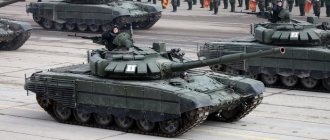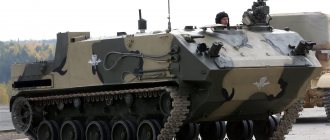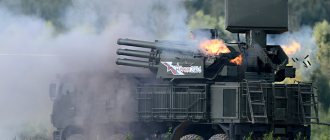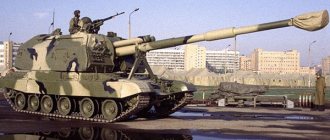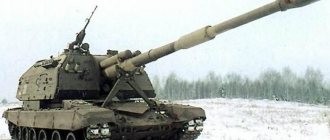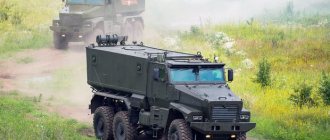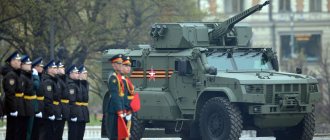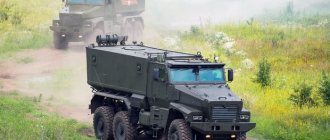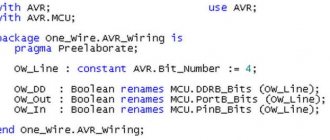Armored vehicle KAMAZ-63968 Typhoon-K TTX, Video, Photo
KAMAZ-63968 "Typhoon-K" with a Remotely Controlled Combat Module
KAMAZ-63968 "Typhoon-K" is a universal armored vehicle with increased security on the original chassis. Compatible with MRAP type vehicles. It is part of the Typhoon family of armored vehicles. The armored vehicle was created after the approval of the Concept for the development of military vehicles of the Armed Forces of the Russian Federation for the period until 2022, which outlines the production of vehicles based on unified families.
Broad cooperation
The creation of the Typhoon family of high-security vehicles began after the adoption in 2010 of the “Concept for the development of military vehicles of the Armed Forces of the Russian Federation for the period until 2022.” Mainly, the document envisaged the decommissioning of obsolete VAT and the creation of unified promising models.
Commenting on the concept on the pages of the Military-Industrial Courier newspaper, the head of the Main Armored Directorate of the Ministry of Defense, Major General Alexander Shevchenko, said that in modern conditions there is a demand for “high-speed vehicles of various payloads and purposes, ensuring the mobility of combat units and rear units.”
In his opinion, the new generation VAT should have high cross-country ability “in difficult road conditions”, a smooth ride, stability and controllability at high speeds, and be unnoticeable to enemy technical reconnaissance equipment
Also, as Shevchenko noted, it is necessary to pay attention to the safety of the crew
As part of the development work (R&D) on the Typhoon project, domestic enterprises developed a single unified automobile platform, a new generation diesel engine, an automatic hydromechanical gearbox, a controlled suspension, an armored functional module, a frame-panel cabin, combat-resistant tires with adjustable pressure, equipment bulletproof and mine protection, as well as a combat information control system (CIUS). More than 120 enterprises of the Russian Federation took part in the implementation of the Typhoon design and development project.
A rather complex cooperation chain was built, including the Ural Automobile Plant (Miass), KamAZ (Naberezhnye Chelny), Remdizel CJSC (Naberezhnye Chelny), Steel Research Institute (Moscow), Federal State Unitary Enterprise "Federal Nuclear Center" (Sarov), (Gus-Khrustalny ) and MSTU im. Bauman (Moscow).
The first to be presented to the general public (at the parade on May 9, 2014) was the Typhoon-K (KAMAZ-63968), a universal six-wheeled armored vehicle designed to transport from 10 to 16 military personnel. The weight of the vehicle is 21 tons, the power of the YaMZ-5367 engine is 450 horsepower, the maximum speed is 105 km/h, the cruising range is 1.2 thousand km.
In 2015, a frame car “Typhoon-U” (Ural-63095) weighing 24.5 tons appeared on Red Square. It is capable of transporting up to 16 military personnel or cargo weighing up to 4 tons. The speed of the car on the highway is 100 km/h, the range is 1.4 thousand km. Both Typhoons are equipped with video cameras, night vision devices and remote-controlled weapons.
Now the Ministry of Defense is considering the possibility of installing on the Typhoon-K a remote-controlled combat module (BMDU) Arbalet-DM developed by the Kovrov Electromechanical Plant. The complex allows the vehicle crew to fire from a 12.7-mm 6P49 Kord machine gun in all directions. The target recognition range, depending on terrain conditions, is 1.5–2.5 km.
To date, several hundred Typhoons have been delivered to the troops. Their main operators are units of combined arms reconnaissance, Special Operations Forces, engineering troops and military police. In 2016, KamAZ-63968 and Ural-63095 were deployed to Syria to transport cargo and military personnel. In particular, sappers and military police rode on Typhoons.
In addition to vehicles weighing over 20 tons, the Typhoon family is represented by two four-wheeled vehicles - K-4386 Typhoon-VDV (Wolverine) and KamAZ-53949 Typhoon. The power of the 6-cylinder engine of both models is 350 horsepower. The vehicles can carry up to 10 paratroopers or two tons of cargo.
KAMAZ-63968 Typhoon-K - video of explosion
KAMAZ-63968 "Typhoon" is part of a new stage in the development of domestic vehicles for the armed forces, since the last time the vehicle platform was adopted was in 1961.
The history of the entire Typhoon family begins in 2010, when the Minister of Defense approved the “Concept for the development of military vehicles of the Armed Forces of the Russian Federation for the period until 2022,” which prescribes the development of highly standardized families of armored vehicles. As a result, a single wheeled cargo platform “Typhoon” was created, providing high protection for the crew, cargo and vehicle components from small arms and landmines. And also on which you can mount various target equipment and create the necessary modifications on the base, such as communication vehicles, mobile artillery systems, truck cranes, UAV transport and launch vehicles, tow trucks, excavators and others.
The creation was carried out by auto specialists, Avtodizel OJSC, GAZ Group, KAMAZ OJSC Scientific and Technical Center, the Steel Research Institute - where the vehicle's armor was designed, the Federal Nuclear Center in Sarov, which calculated the security of the armored hull, which was involved in the creation of armored glass, MSTU named after. N. E. Bauman, who was involved in the development of hydropneumatic suspension and many other companies and research institutes. The need to create such vehicles was dictated by the fact that the bulk of combat losses in the troops occur from the explosion of vehicles in a minefield or from landmines during the movement of columns. In December 2014, the first batch of 30 armored vehicles arrived in the Southern Military District. In January 2015, the Southern Military District received another 20 units.
Design
The armor was made in accordance with level 3b of the NATO classification STANAG 4569, according to which the vehicle can withstand the detonation of high-explosive fragmentation devices weighing 8 kg in TNT equivalent under any place in the vehicle, since this is the first time that vehicles of this kind are being made in Russia and there are no generally accepted state standards for the classification of explosions. Bulletproof protection corresponds to the fourth level.
Combined ceramic and steel armor is installed, which protects against armor-piercing bullets of 14.5x114 mm caliber. Including armored glass with a thickness of 128.5-129.0 mm with a transparency of 70%, developed and tested at the Steel Research Institute, which can withstand 2 shots with a distance between them of 280-300 mm when fired from a KPVT with a bullet speed of 911 m/s at the moment of contact with glass. Bullet resistance exceeds the highest requirements according to existing GOSTs (GOST R 51136 and GOST R 50963), in which the highest level is firing with B-32, 7.62x54 mm armor-piercing cartridges from SVD. During production, Magistral-LTD was guided by Western standards of level IV STANAG 4569 - guaranteed protection when fired by armor-piercing ammunition B-32, 14.5 × 114 mm from a distance of 200 m with a bullet speed of 891-931 m/s.
The armor can withstand hits from 30mm ammunition. There are bulletproof tires 16.00R20 with anti-explosive inserts that remove the blast wave, with automatic air pumping and adjustable pressure up to 4.5 atmospheres. The armored module is equipped with embrasures for firing from small arms, and a remote-controlled machine gun can also be installed on it. Unification with other cars of the family is 86%.
The seats are equipped with personal weapon holders, seat belts and headrests. They are attached to the roof of the module to reduce the impact of mines/land mines. An FVUA-100A filter and ventilation unit and an air conditioner are installed inside the module. There are emergency hatches on the roof in case the car overturns. Landing is carried out through a ramp at the rear of the vehicle or through a door on the side.
Surveillance and communications equipment
The car is equipped with an Onboard Information and Control System (BIUS) GALS-D1M for monitoring and regulating engine operation, calculating vehicle roll, road inclination, speed, location, etc. Independent hydropneumatic suspension allows the driver to change the ride height on the go, using remote control within 400mm. KAMAZ-63968 is equipped with five video cameras for all-round visibility in the landing module and cabin. The cabin is equipped with folding monitors showing both the vehicle's condition and external visibility.
Byproduct
Chelny residents showed the armored combat vehicle (AFV) KAMAZ-53949 “Typhoon” to the general public at the Moscow exhibition “Interpolitex-2014”. From a conversation with specialists, it turned out that at that time this was the only example of their “Typhoon” 4x4 and its development was carried out on a proactive basis. The vehicle turned out to be more compact than the Typhoon-U - Ural-53099: length 6374 mm versus 7810 mm for the Ural, primarily due to the short wheelbase (3800 mm versus 4860 mm). Due to its high security, the vehicle’s curb weight was 12 tons, which is 0.8 tons less than the more compact VPK-3924 “Bear” (see “GP” No. 8, 2011). The dimensions and weight of the vehicle are formed taking into account the requirements of the Airborne Forces for cargo transported by military transport aircraft Il-76, An-124 and Mi-26 helicopters.
The vehicle belongs to the MRAP class and provides mine protection for personnel according to the requirements of STANAG-4569 levels III-b and IV-a. It is supposed to withstand the detonation of a high-explosive anti-tank mine with a charge mass in TNT equivalent (TE) of 10 kg - under the wheel, 8 kg - under the bottom.
The armor of the hull, designed for two crew members and eight paratroopers with full combat equipment, corresponds to level III of the NATO standard. Israeli Plasan Sasa armor assumes protection of the crew from damage by 14.5 mm caliber ammunition, armor-piercing bullets of the B-32 type, and 7.62 mm x 54R armor-piercing incendiary bullets used in SVD rifles.
The design of the vehicle was somewhat confusing with the fuel tanks located in the stern and access to the rear troop compartment through a door in the rear panel: to open it, you must first fold back the ladder.
Considering that the premiere took place in 2014, the widespread use of imported auto components, and in a wider range than on the Typhoon-K 6x6, became alarming. The 350-horsepower Cummins 6ISBe diesel engine was coupled with an Allison 6-speed automatic transmission, Timoney transfer case and axles, Hutchinson wheels, Dutch independent hydropneumatic suspension (HPP) with automatic tire inflation. And this is not counting imported Hella air conditioners and lighting equipment. Compared to cars of the older family, combat-resistant Michelin tubeless tires have a smaller size (by 1 step) - 14.00 R20 and ensure movement (of a damaged tire) at speeds of up to 50 km/h for a distance of up to 50 km.
The equipment includes automatic locking of inter-wheel and center differentials. A specialized on-board information and control system (BIUS) must monitor the status of all systems and the presence of malfunctions. Its main functions included calculating optimal movement parameters (clearance, suspension operating mode, etc.) and transmitting the corresponding commands to control the systems and mechanisms of the armored car.
When examining the first KAMAZ-53949, several holes in the wing niches caused amazement. It turned out that after testing, the sample was disassembled for inspection. And on reassembly, it turned out that during testing, individual parts became deformed, and the fastening bolts could no longer be inserted into the holes without significant force. It happens, it happens... But the reassembled “typhoon baby” has not lost its functionality. Practice shows that on prototypes it is often much worse - some samples cannot even be driven later.
In general, the KAMAZ-53949 sample was driven quite well last year!
Testers noted the reliability of the Allison automatic transmission and the insufficient reliability of the Timoney transfer case. Tactical and technical characteristics of the prototype "Typhoon-K" 4x4 KAMAZ-53949
| Curb weight, kg | 12 000 |
| Total weight, kg | 14 000 |
| Load capacity, kg | 2000 |
| Capacity, persons | 10 |
| Engine displacement, cm3 | Cummins 6ISBe 350, turbodiesel, I-6 6690 |
| Power, hp | 350 |
| Torque, N∙m | 1090 |
| Climbing angle, % | 60 |
| Maximum speed, km/h | 105 |
| Cruising range, km | 850 |
| Fording depth, mm | 1750 |
| Wheels | 10.00 20 |
| Tires | Michelin XZL+, 14.00 R20 |
| Ballistic protection level, bullet caliber | STANAG-4569 level III, 7.62 mm x 54R SVD |
| Mine protection level | STANAG-4569 level III-b and IV-a, 10 kg in fuel cell under the wheel and 8 kg in fuel cell under the bottom |
Performance characteristics of KAMAZ-63968 Typhoon-K
Crew, people: 2 Troops, people: 16 Manufacturer: KamAZ Years of development: 2010-2015 Number of produced, pcs.: 260
Weight KAMAZ-63968 Typhoon-K
— 21 tons
Dimensions of KAMAZ-63968 Typhoon-K
— Case length, mm: 8990 — Case width, mm: 2550 — Height, mm: 3300 — Ground clearance, mm: adjustable from 185 to 575 mm
Armor KAMAZ-63968 Typhoon-K
— Combined armor made of ceramic and steel, which protects against armor-piercing bullets of 14.5x114 mm caliber. Including armored glass with a thickness of 128.5-129.0 mm
Engine KAMAZ-63968 Typhoon-K
— Engine type: YaMZ-5367 — Engine power, l. pp.: 450
Speed KAMAZ-63968 Typhoon-K
— Maximum speed, km/h: 105 km/h — Cruising range on the highway, km: 1200 — Fuel consumption per 100 km: no more than 35 liters — Wheel arrangement: 6 × 6 / 4 — Suspension type: controlled hydropneumatic
New modification
The KAMAZ-53949 vehicle presented at Interpolitech 2014 was impressive. But he skipped the Army-2015 forum for a good reason: at that time he was being converted into a reconnaissance vehicle for display at the MAKS-2015 air show.
By this time, KAMAZ had distanced itself from the production of the Special Vehicles Plant, which became part of Remdizel OJSC. The Tula OJSC NPO Strela became interested in the machine. Previously, it produced a similar service-combat reconnaissance vehicle SBRM on the Tiger chassis (see GP, No. 9, 2012). But with the YaMZ engine it turned out to be cramped and heavier.
The purpose of the new reconnaissance vehicle, in which the number of seats has been reduced to 4 crew members, includes search, detection and identification of ground, surface stationary and moving targets in the daytime and at night, as well as solving problems of suppressing detected targets. This list also includes crew protection. The equipment includes a lifting-mast device with an optical-electronic system and radar, remotely controlled weapons with a 12.7 mm machine gun, a drone with a replaceable optical load, and a hexacopter with a replaceable optical or radar load.
The characteristics of the installed equipment make it possible to detect a human figure at a distance of 6 km, and a tank – 15 km. In automatic mode, the target-tank system recognizes at a distance of 4–6 km.
The hexocopter, which takes up half the space in the body, can hover above the ground for an hour at an altitude of up to 500 m in autonomous mode. When powered by a cable, the aircraft rises 50 m, since it also has to pull the wire from the ground.
In addition, CJSC Scientific and Technical Center Elins, CJSC Central Research Institute Burevestnik, CJSC TPK Linkos and CJSC NPO NELK participated in the development of a new type of reconnaissance vehicle. What will happen to this car and the Typhoon-K in particular has not yet been determined, but among the first tasks, of course, the car needs a domestic engine and transmission group.
Modifications
Typhoon K-63968
Main article: KAMAZ-63968
Cabover multifunctional modular vehicle. In the modification for transporting personnel, it can transport up to 10 or 16 people. Landing can be carried out either using a ramp or through a door. The front of the cabin has reinforced armor, which provides protection from 30-mm shells; It is possible to install an armor shield covering the windshield. According to other sources, the armor is only designed to withstand 7.62 mm bullets, which corresponds to category 3 according to STANAG. Mine protection corresponds to category 3b. The landing compartment is equipped with triplexes, as well as monitors displaying information from external video cameras. Currently in mass production.
Typhoon K-63969
An armored personnel carrier with a 6x6 wheel arrangement and a remote-controlled gun. Single-volume armored module (cabin and body are a single structure). It was first publicly shown in June 2013 in the workshop during the assembly stage. It has all-round armor designed to withstand 14.5 and 12.7 mm caliber bullets (corresponds to level 4 according to STANAG 4569). Mine protection corresponds to level 3b. The vehicle's curb weight is 19.7 tons, payload is 4 tons. Not mass produced.
Typhoon K-53949 “Typhoon 4x4”
Typhoon K-53949 at the Victory Parade in 2022.
Multi-purpose off-road armored vehicle, army off-road vehicle with 4x4 wheel arrangement. It has a combined protection made of ceramic armor, with armor steel underneath. The total weight is more than 15 tons, the maximum speed is 105 km/h.
Application: protection and escort of convoys, sanitary transportation, engineering, radiation, chemical and biological reconnaissance, reconnaissance and command post vehicle, fire support vehicle. The car was first presented at the Innovation Day of the Southern Military District in October 2015.
Ural-63095 "Typhoon-U"
Main article: Ural-63095
Inside the armored capsule Ural-63099
Hooded multifunctional modular vehicle (three-seater armored cabin and interchangeable body-armored module).
Armament
A remote-controlled machine gun with servo drives is installed on the roof of the armored vehicle, which is capable of non-stop firing until the ammunition runs out. The armored KamAZ "Typhoon" is practically invulnerable to light small arms carried by enemy infantry, and can travel a considerable distance under fire. The vehicle can only be stopped by an anti-tank gun firing cumulative shells. If damaged, the Typhoon can be quickly restored in a repair shop thanks to its high unification, reaching 86% (compared to other models of its family).
Supplies
Such widespread use of the vehicle allowed strategic military formations to solve almost all current tasks related to transportation. The engineering troops were equipped with a universal truck in the required volume. Last December, the new military KamAZ "Typhoon" began to arrive in military units. The advanced design has a high degree of survivability; The most vulnerable point of all army transporters - the bottom - of the modern Typhoon has received enhanced armor protection.
Variation
The basic KamAZ "Typhoon", the photo of which is posted on the page, opened up the possibility of creating a number of modifications on its platform, such as communications vehicles, mobile artillery systems, truck cranes with increased lifting capacity, transport and launch mobile devices for launching UAVs (unmanned aerial vehicles). In addition, military KamAZ "Typhoon" trucks were used as tow trucks, which could load even a tank onto their platform using a powerful winch and take it to the repair site. Wheeled excavators and trenchers were also created on the basis of the Typhoon.
Cross-country ability, reliability, low cost
The developers paid special attention to the security of the Typhoon family. The car body consists of a metal shell, a layer of ceramic protection and a main armor plate
The glass can withstand bullets of 7.62 mm, 12.7 mm and (under certain conditions) 14.5 mm calibers.
The transmission is equipped with an automatic tire inflation system, powered by the engine running. In addition, a special plastic insert is placed on the wheel rim. In case of serious damage (blown rubber), the Typhoon is able to “crawl” at low speed, relying on plastic inserts. The car can continue to move even after several hits on the wheels.
All members of the family must withstand the detonation of a land mine with a capacity of up to 8 kg of TNT equivalent. To reduce the likelihood of the crew dying from a mine explosion, the designers used a V-shaped hull bottom. Changes also affected the interior layout. The paratroopers sit facing each other, and their chairs are equipped with means that absorb the energy of the explosion. The most vulnerable transmission units are covered with armor plates.
In a conversation with RT, candidate of military sciences Sergei Suvorov said that Russian designers have created reliable and effective models of military aircraft capable of solving assigned tasks under cover and in the rear. However, progress does not stand still. The Ministry of Defense is looking for ways to further improve the Typhoons and is working on the concept of a new generation armored vehicle, the expert believes.
“In my opinion, the Typhoons optimally combine the main combat properties - maneuverability, reliability, and relative low cost of production. In the future, these machines may receive more serious protection and automated control systems
It is very important that the military clearly formulate its requirements. With well-coordinated interaction between the Ministry of Defense and industrialists, magnificent samples will appear that will be in demand both in our army and abroad,” Suvorov emphasized
“I boldly go towards execution.” How a soldier of the Nazi Wehrmacht became a hero of the USSR
